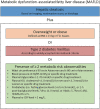Malaysian Society of Gastroenterology and Hepatology consensus statement on metabolic dysfunction-associated fatty liver disease
- PMID: 35080048
- PMCID: PMC9303255
- DOI: 10.1111/jgh.15787
Malaysian Society of Gastroenterology and Hepatology consensus statement on metabolic dysfunction-associated fatty liver disease
Abstract
The Malaysian Society of Gastroenterology and Hepatology saw the need for a consensus statement on metabolic dysfunction-associated fatty liver disease (MAFLD). The consensus panel consisted of experts in the field of gastroenterology/hepatology, endocrinology, bariatric surgery, family medicine, and public health. A modified Delphi process was used to prepare the consensus statements. The panel recognized the high and increasing prevalence of the disease and the consequent anticipated increase in liver-related complications and mortality. Cardiovascular disease is the leading cause of mortality in MAFLD patients; therefore, cardiovascular disease risk assessment and management is important. A simple and clear liver assessment and referral pathway was agreed upon, so that patients with more severe MAFLD can be linked to gastroenterology/hepatology care, while patients with less severe MAFLD can remain in primary care or endocrinology, where they are best managed. Lifestyle intervention is the cornerstone in the management of MAFLD. The panel provided a consensus on the use of statin, angiotensin-converting enzyme inhibitor or angiotensin receptor blocker, sodium-glucose cotransporter-2 inhibitor, glucagon-like peptide-1 agonist, pioglitazone, vitamin E, and metformin, as well as recommendations on bariatric surgery, screening for gastroesophageal varices and hepatocellular carcinoma, and liver transplantation in MAFLD patients. Increasing the awareness and knowledge of the various stakeholders on MAFLD and incorporating MAFLD into existing noncommunicable disease-related programs and activities are important steps to tackle the disease. These consensus statements will serve as a guide on MAFLD for clinicians and other stakeholders.
Keywords: MAFLD; MSGH; Malaysia; Malaysian Society of Gastroenterology and Hepatology; NAFLD; consensus; metabolic dysfunction-associated fatty liver disease; multi-disciplinary; non-alcoholic fatty liver disease.
© 2022 The Authors. Journal of Gastroenterology and Hepatology published by Journal of Gastroenterology and Hepatology Foundation and John Wiley & Sons Australia, Ltd.
Figures



Similar articles
-
Non-invasive screening, staging and management of metabolic dysfunction-associated fatty liver disease (MAFLD) in type 2 diabetes mellitus patients: what do we know so far ?Acta Gastroenterol Belg. 2022 Apr-Jun;85(2):346-357. doi: 10.51821/85.2.9775. Acta Gastroenterol Belg. 2022. PMID: 35709779 Review.
-
An international multidisciplinary consensus statement on MAFLD and the risk of CVD.Hepatol Int. 2023 Aug;17(4):773-791. doi: 10.1007/s12072-023-10543-8. Epub 2023 May 19. Hepatol Int. 2023. PMID: 37204656 Free PMC article.
-
The Chinese Society of Hepatology position statement on the redefinition of fatty liver disease.J Hepatol. 2021 Aug;75(2):454-461. doi: 10.1016/j.jhep.2021.05.003. Epub 2021 May 19. J Hepatol. 2021. PMID: 34019941
-
An international multidisciplinary consensus on pediatric metabolic dysfunction-associated fatty liver disease.Med. 2024 Jul 12;5(7):797-815.e2. doi: 10.1016/j.medj.2024.03.017. Epub 2024 Apr 26. Med. 2024. PMID: 38677287
-
The NAFLD-MAFLD debate: Is there a Consensus-on-Consensus methodology?Liver Int. 2022 Apr;42(4):742-748. doi: 10.1111/liv.15197. Epub 2022 Feb 24. Liver Int. 2022. PMID: 35182007 Review.
Cited by
-
Comparison between obese and non-obese nonalcoholic fatty liver disease.Clin Mol Hepatol. 2023 Feb;29(Suppl):S58-S67. doi: 10.3350/cmh.2022.0350. Epub 2022 Dec 5. Clin Mol Hepatol. 2023. PMID: 36472052 Free PMC article. Review.
-
Liver dysfunction in adults with COVID-19 infection: A longitudinal study with transient elastography evaluation.JGH Open. 2024 Aug 7;8(8):e13118. doi: 10.1002/jgh3.13118. eCollection 2024 Aug. JGH Open. 2024. PMID: 39114430 Free PMC article.
-
MAFLD: what 2 years of the redefinition of fatty liver disease has taught us.Ther Adv Endocrinol Metab. 2022 Nov 22;13:20420188221139101. doi: 10.1177/20420188221139101. eCollection 2022. Ther Adv Endocrinol Metab. 2022. PMID: 36439029 Free PMC article. Review.
-
Non-invasive biomarkers for liver inflammation in non-alcoholic fatty liver disease: present and future.Clin Mol Hepatol. 2023 Apr;29(2):401-403. doi: 10.3350/cmh.2023.0062. Epub 2023 Feb 28. Clin Mol Hepatol. 2023. PMID: 36858457 Free PMC article. No abstract available.
-
Metabolic Dysfunction-Associated Steatotic Liver Disease (MASLD): A State-of-the-Art Review.J Obes Metab Syndr. 2023 Sep 30;32(3):197-213. doi: 10.7570/jomes23052. Epub 2023 Sep 13. J Obes Metab Syndr. 2023. PMID: 37700494 Free PMC article. Review.
References
-
- Eslam M, Newsome PN, Sarin SK et al. A new definition for metabolic dysfunction‐associated fatty liver disease: an international expert consensus statement. J. Hepatol. 2020; 73: 202–209. - PubMed
-
- Younossi ZM, Rinella ME, Sanyal AJ et al. From NAFLD to MAFLD: implications of a premature change in terminology. Hepatology 2021; 73: 1194–1198. - PubMed
-
- Fouad Y, Waked I, Bollipo S, Gomaa A, Ajlouni Y, Attia D. What's in a name? Renaming ‘NAFLD’ to ‘MAFLD’. Liver Int. 2020; 40: 1254–1261. - PubMed
-
- Wai‐Sun Wong V, Kanwal F. On the proposed definition of metabolic‐associated fatty liver disease. Clin. Gastroenterol. Hepatol. 2021; 19: 865–870. - PubMed
Publication types
MeSH terms
Substances
LinkOut - more resources
Full Text Sources
Medical

